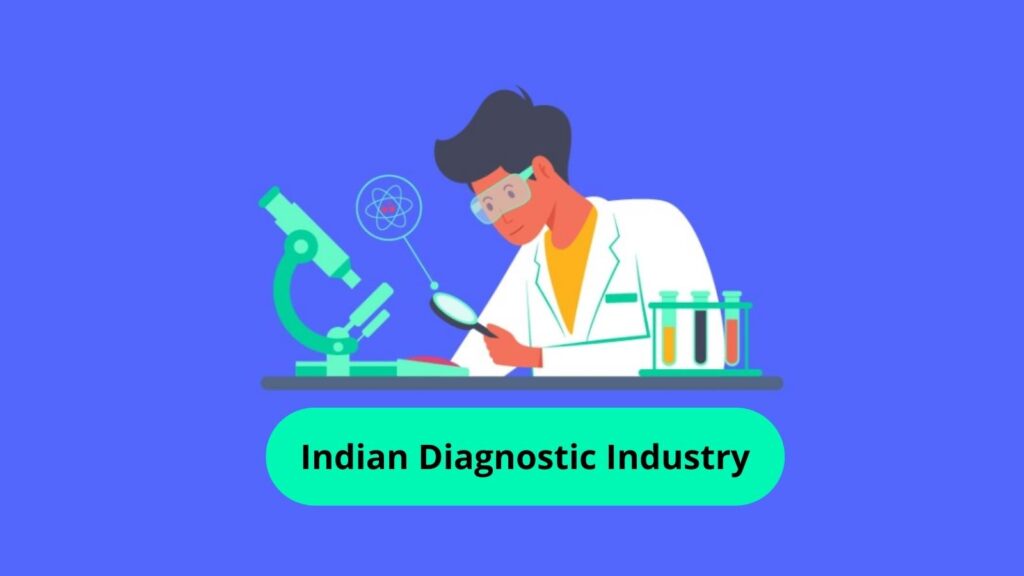Fact : During a patient’s journey, 70% of medical decisions are based on laboratory results.


Quick Links for Indian Diagnostic Industry. Click to navigate directly to the paragraph in detail:
- Overview : Healthcare
- About the Indian Diagnostic Industry
- Players in the Diagnostic Industry
- Industry Key Metrics
- Illustration : Patient journey
- Outlook
- Growth Triggers

(A) Overview of the Healthcare Industry
2020 was the year when the Global Healthcare industry witnessed a sudden shock due to the outbreak of a pandemic that is Covid-19. Covid virus emerged as one of the deadliest diseases of all times.
Not only for citizens but also for research companies, the virus was completely new, that took millions of lives around the globe. However, to stop more killings, the Diagnostic Sector took command and acted as a remedy for this virus.
In order to avail suitable solution, from starting phase of researching, testing, evaluating till launching of Covid vaccines. “Diagnostic sector has played a major role”.
(B) About the Indian Diagnostic Industry
Diagnostic services are acting as an intermediary in India’s healthcare industry. In addition, These services are offering valuable and useful information for accurate diagnosis and treatment of diseases.
In FY15, The Diagnostic Market size was ₹377 billion. Organized Chains had 15% market share.
The Market size grew to ~₹730bn with 17% Market Share of organized diagnostic chains in FY21. Moreover, it is expected that the market will grow to ₹980 bn from FY21-FY23 with 14-16% of CAGR.
Doctor referrals constitute a large part of this business. This includes commission payments to doctors instead of referring to a diagnostic lab.
Further, the illness diagnosis segment is more prevalent than the wellness segment in India.

The Diagnostics industry includes 3 segments namely (i) Pathology, (ii) Radiology and (iii) Wellness services.
- Pathology includes multiple services such as blood tests, and tests of urine, stools (faeces), body tissues, and many others.
- On the other hand, Radiology services include x-rays, ultrasound, bone mineral densitometry, fluoroscopy, mammography, nuclear medicine, CT and MRI.
- Whereas Wellness Services Includes tests related to pre-existing diseases, diet imbalance tests, overweight and underweight tests and many others.
Pathology services contribute about 60-70% of the overall revenue. whereas Radiology Services and wellness account for 40% of the overall revenue of the diagnostics business.
(C) Players in the Diagnostic Industry

In India, there are mainly four major players – Dr Lal PathLabs, Metropolis Healthcare, SRL Diagnostics and Thyrocare Technologies which aggregate ~6% of market share.
According to several Industry reports, organized players with national presence would grow at 15-17% CAGR over the next five years and will continue to garner market share, led by asset light models and strong cash flows.
Even though, industry leaders have started to implement initiatives such as retailer partnering, offering home testing, and enhancing engagement with patients through digital presence to flourish their sales.
(D) Industry Key Metrics
(i) Division of the Healthcare Industry

Indian Healthcare is categorized into 5 divisions. The largest proportion has been covered by Delivery Hospitals which is 68%. Then, Pharma sector covers 13% and medical Devices covers 9% of the healthcare industry.
whereas, 6% covered by Diagnostics Market.
Additionally, India currently holds the fourth position in attracting VC funding to the health-tech sector, with investments of US$ 4.4 billion between 2016 and 2021, with US$ 1.9 invested in 2021 alone.
(ii) Diagnostics chains Presence – Pan India and Regional
The Domestic Diagnostic chains has a presence in (i) Regional chains which cover 40% market Share of Organised diagnostic market, whereas (ii) Pan India Chains cover 60% market share of organized diagnostic market.
Regional Diagnostic chains are smaller chains which has a presence in particular city and town, whereas Pan India Chains has wider spread over the whole country.

(E) Patient journey
(i) Historic
Historically, the focus was on clinical excellence for high-end tests, and patient centricity took a back seat. Patients used to travel long distances to get high-end tests done, thus resulting in high travelling cost, loss of a complete day (loss of wages) and higher wait time for these diagnostic tests.
Further, Through the use of technology, diagnostics chains have altered the business model and shifted the focus to patient comfort. The journey of a patient has changed in the current scenario.

(ii) Current
In the present scenario, the focus has also shifted towards patient centricity; the industry has innovated the service delivery model and is providing quality services. The innovations include collection centres and home sample collection, reduced turnaround time for report generation, and rapid alerts to customers.
However, The evolution of the Indian diagnostic industry has brought in significant savings in time, thus preventing loss of wages for getting a diagnostic test conducted.

(F) Outlook
(i) Indian Healthcare Ecosystem
Indian healthcare industry comprising manufacturing and marketing of pharmaceuticals and active ingredients, hospital chains, insurance companies and diagnostic outfits, stands at an estimated $194 Bn, while expected to reach $372 Bn by 2022.
Latest research corroborates the view that, India has one of the lowest per capita expenditures on healthcare. However, in recent years, various policies have devised to overcome this statistic.
The Govt of India is planning to increase public health spending to 2.5% of the country’s GDP by 2025. However, As per the Economic Survey of 2022, India’s public expenditure on healthcare stood at 2.1% of GDP in 2021-22 against 1.8% in 2020-21.
The Sources suggest that, Between April 2000-December 2021,
- FDI inflows for drugs and pharmaceuticals sector stood at US$ 19.19 Bn,
- On the other hand, FDI inflows in sectors such as hospitals and diagnostic centers and medical & surgical appliances stood at US$ 7.73 billion and US$ 2.35 billion, respectively.
In addition, During Union Budget of 2022-2023 :
- Rs. 86,200.65 crore (US$ 11.28 billion) allocated to the Ministry of Health and Family Welfare (MoHFW).
- After that, The Government of India approved continuation of ‘National Health Mission’ with a budget of Rs. 37,000 crore (US$ 4.85 billion).
- Furthermore, Rs 5,156 crore (US$ 675.72 million) allocated to the newly announced PM-ABHIM to strengthen India’s health infrastructure and improve the country’s primary, secondary and tertiary care services.
(ii) Diagnostic Industry
Diagnostic is the central component for the detection, diagnosis, and assessment of any disease.
In Fact, Around 70% of the medical decisions related to disease diagnosis, management, and prevention are based on diagnostics.
A diagnostic is a crucial tool in preventive healthcare. From the new age of the Covid virus to the old Mutant of Swine Flu, Dengue etc, all have been identified by the Diagnostic industry with help of hi-tech Machines and Devices.
In FY15, The Diagnostic Market size was ₹377 billion. Organized Chains had 15% market share.
The Market size grew to ~₹730bn with 17% Market Share of organized diagnostic chains in FY21. Moreover, it is expected that the market will grow to ₹980 bn from FY21-FY23 with 14-16% of CAGR.
Furthermore, It is believed that the industry will grow at a CAGR of ~11% over the next five years, primarily driven by an increase in healthcare spending, rising income levels, and raising awareness of preventive testing.
Although the Indian diagnostic market is small yet compared to those in developed countries, it is amongst the fastest-growing segments in the healthcare market.
(G) Growth Triggers
(i) Population dynamics
The population of senior citizens is growing at 4-4.5%, thus providing ample opportunity to the diagnostic sector. Increase in life expectancy along with increase in lifestyle-related diseases contribute to the sector.
The share of those above 65 years (at ~90 Mn as at the end of CY20) will increase, giving rise to elevated requirement for chronic care.
(ii) Rise in income level and urbanization
As the economy expands the proportion of spending allocated to healthcare too will rise.
On a base of ~480 Mn for the urban population, the incremental private spends on testing can be expected to be large.
(iii) Penetration of organized health coverage
Insurance-backed and publicly funded healthcare schemes will become the mainstay of the diagnostics industry as the economy develops. However, Incentives from the Government too will play a role to encourage higher preventive testing amongst the population.
(iv) Bundled offerings/healthcare packages
Industry leaders are offering Bundle healthcare packages which will carve out a niche segment that prioritizes preventive and well-being based check ups.
Moreover, By offering bundle Packages customers will get popular testing or screening in very affordable prices which will fuel the volumes.
(v) Services at Customer’s Door Step
Well Established Diagnostics Chains are working with their phlebotomists, to provide basic testing like Urine, blood, Stool, Sugar within customer’s door step for their convenience and time availability.
(vi) Consolidation of the unorganized players
Consolidation of the unorganized players will be a key feature, constantly shaping the diagnostics sector where scale and technology will play a crucial role in growth.
(vii) Technology
Third party aggregators opening up additional channels through the online route. Diagnostic chains will evolve a model to co-opt their presence with their own online set-ups.



Drop us your query at – info@pawealth.in or Visit pawealth.in
References: Annual Reports, News Publications, Investor Presentations, Corporate Announcements, Management Discussions, Analyst Meets & Management Interviews, Industry’s Publications.
Disclaimer: The report only represents personal opinions and views of the author. No part of the report should be considered as recommendation for buying/selling any stock. Thus, the report & references mentioned are only for the information of the readers about the industry stated.
Most successful stock advisors in India | Ludhiana Stock Market Tips | Stock Market Experts in Ludhiana | Top stock advisors in India | Best Stock Advisors in Gurugram | Investment Consultants in Ludhiana | Top Stock Brokers in Gurugram | Best stock advisors in India | Ludhiana Stock Advisors SEBI | Stock Consultants in Ludhiana | AMFI registered distributor | Amfi registered mutual fund | Be a mutual fund distributor | Top stock advisors in India | Top stock advisory services in India | Best Stock Advisors in Bangalore




